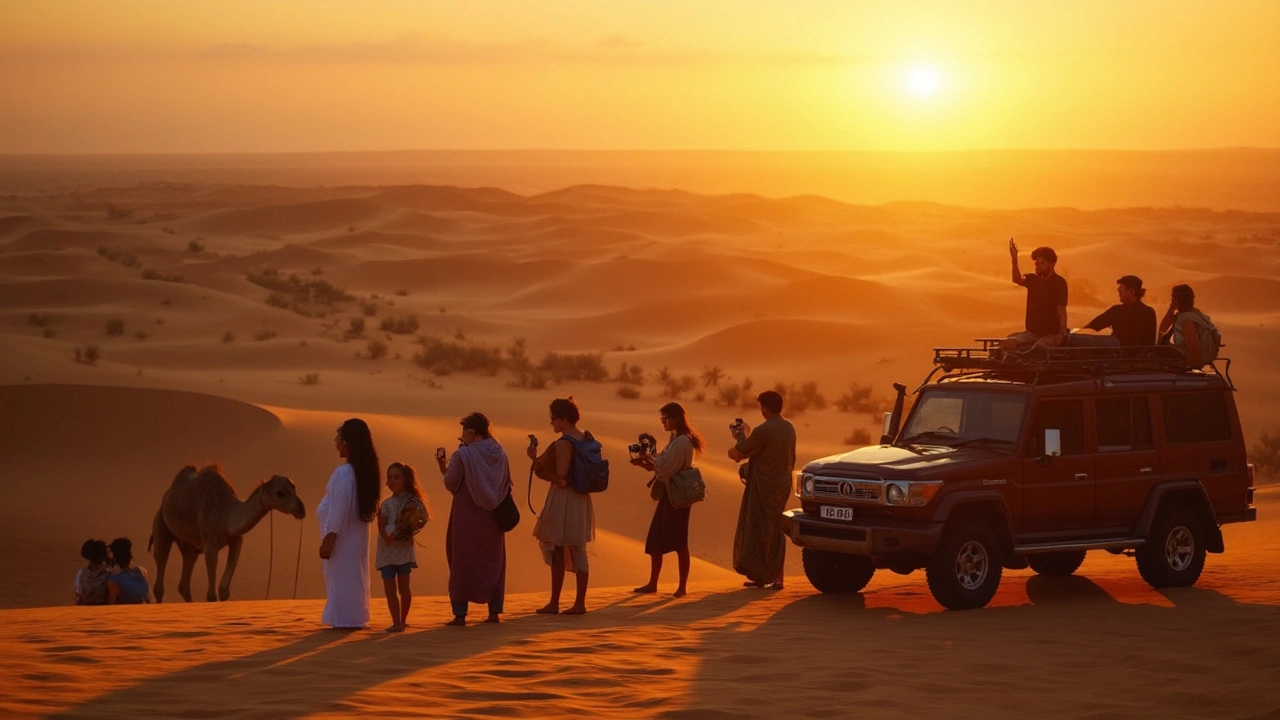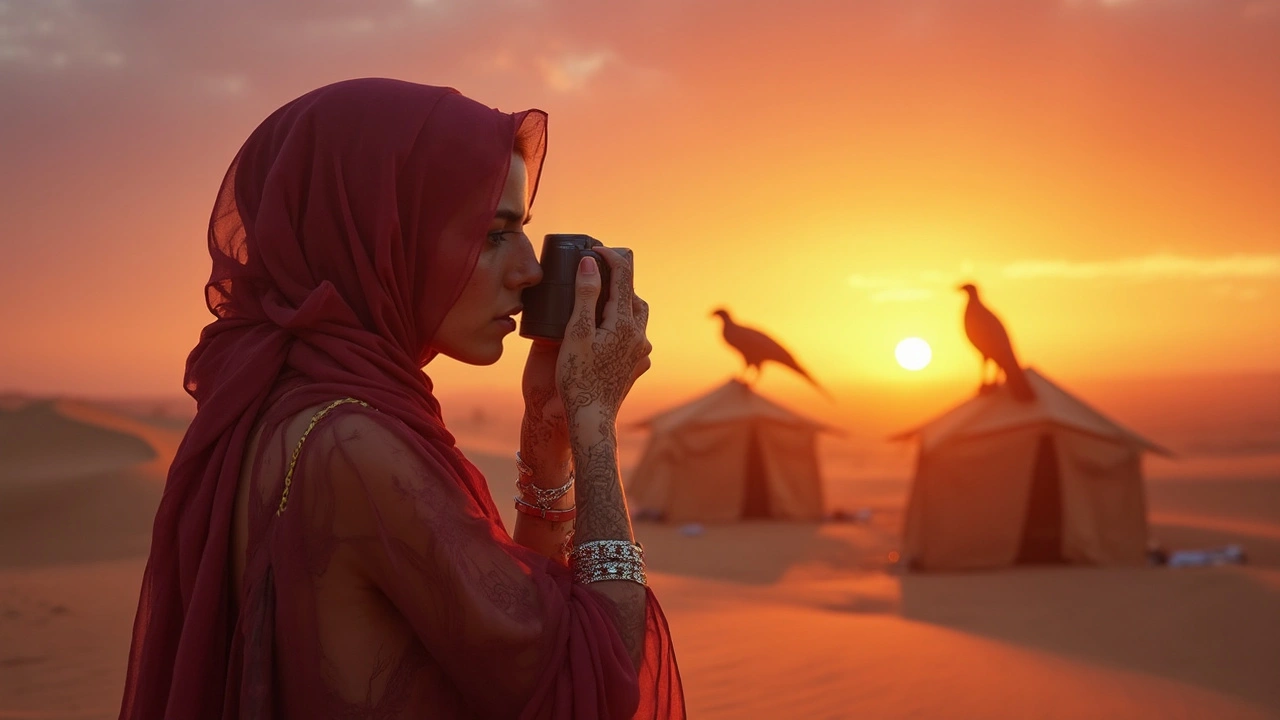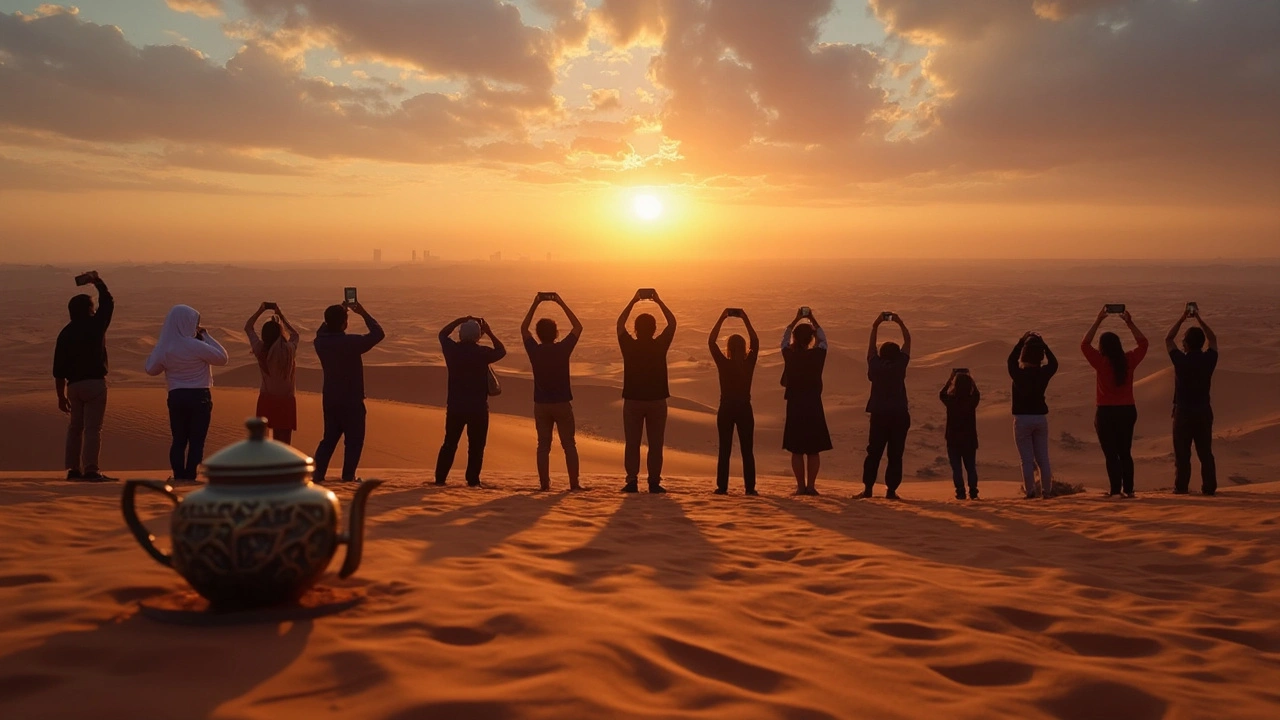
Catching those unbelievable desert colors in Dubai isn’t just luck—it’s all about timing and knowing exactly where to be. The wide open stretches of sand just outside the city, from Al Marmoom to the Lahbab dunes, turn into a photographer’s dream starting as early as 5:30 AM. For sunrise, you often need to be up and off Sheikh Zayed Road while the world still sleeps. Sunset hits hard around 6:30 PM, and trust me, the crowds thin out if you pick a weekday or book with reputable providers like Platinum Heritage or Arabian Adventures.
Your clothes matter. Loose, light fabrics will save you from sweating buckets, and sandals just fill up with sand. Always pack water and charge your phone or camera—battery drains fast in the heat and after a round of snapping shots of camels, falcons, or the never-ending dunes. If you’re keen on real Emirati touches, join a camp that offers traditional Bedouin breakfasts or shows, where you can get those action shots of falconry up close—just ask before using the flash; not all animals like the limelight.
- Golden Hour: Why Sunrise and Sunset Matter
- Essential Gear and Desert-Ready Tips
- Top Dubai Safari Operators and Hidden Spotlights
- Local Traditions and Respecting the Desert
- Making Your Moments Last: Editing and Sharing
Golden Hour: Why Sunrise and Sunset Matter
If you want photos that actually pop from your Dubai desert safari, the “golden hour” is your best friend. In Dubai, this light is especially dramatic because of the flat desert and endless sky. The golden hour basically means the first hour after sunrise and the last hour before sunset. That’s when sunlight gets softer, colors come out deep and warm, and shadows make shapes on the sand look a lot cooler than they do at noon.
Here’s the not-so-obvious detail: Dubai’s air is often clear right after dawn or just before dusk, especially outside the humid summer months. That gives you less haze and more punch in your colors—no ugly blue tint. The city’s main desert areas, like Al Marmoom or the Lahbab Red Dunes, are rarely crowded at sunrise but can fill up at sunset, so you need to plan ahead if you want those shots without background photobombers.
- Sunrise in Dubai is usually between 5:30 to 6:00 AM (varies by season). If you want pure, untouched sand in your shots, go early. Most tours can pick you up before dawn.
- Sunset in Dubai happens around 6:00 to 7:00 PM. Most desert safaris plan their activities—like camel rides and sandboarding—right before sunset, so you get maximum photo ops with rich colors and loooong shadows.
Light at these times is not only better for photos, it's easier on your eyes and skin. Midday sun in Dubai can be brutal—nobody looks good squinting, and your camera washes out all color. Most pros in the city will tell you: skip the noon shots, unless you’re going for harsh drama.
| Best Golden Hour Times (Approx.) | Pro Tip |
|---|---|
| May to September: 5:30-6:30 AM & 6:30-7:30 PM | Summer heat means you should shoot early and leave before it gets too hot. |
| October to April: 6:00-7:00 AM & 5:30-6:30 PM | Cooler air and clear skies, perfect for longer shoots. |
Also, it’s worth knowing that desert camps set up traditional activities—like falcon shows or Arabic coffee ceremonies—right at golden hour so you’re not just snapping landscapes, but getting those real UAE moments in perfect light. If you’re into video, golden hour cuts down on harsh shadows on faces too. The bottom line: Chasing the light in Dubai’s desert isn’t a cliché, it’s how you get photos that everyone actually wants to see.
Essential Gear and Desert-Ready Tips
Don't get stuck in the Dubai desert without the right stuff. If you're serious about capturing killer shots on your Dubai desert safari, you want to travel smart and light, but not at the expense of missing a perfect moment because your battery died or you didn't consider the sand.
- Camera or Smartphone: Most modern phones handle desert light pretty well, but if you’re hauling a DSLR, make sure you’ve got a lens hood (the sun is brutal!) and a microfibre cloth. Sand will get everywhere—lens covers and sealed bags are a must.
- Spare Batteries and Memory Cards: High temps eat battery life fast. Bring at least one extra battery and a charged power bank. Memory fills up quick with landscape shots and camel selfies.
- Tripod: Lightweight and sturdy. The desert is windy, so avoid cheap tripods. Look for brands like Manfrotto or Benro—available locally at Sharaf DG and Dubai Mall’s Virgin Megastore.
- Clothing: Go for breathable, long-sleeved tops and trousers. The sun isn’t forgiving, and neither is the sand. Skip open shoes—closed trainers or desert boots make life easier when you’re climbing dunes.
- Water and Snacks: It’s dry out there. Stash a reusable bottle (local favorites: S'well or Chilly’s) and maybe some Medjool dates—energy without the mess.
- Protective Cases: For your phone and camera, look for sand-proof cases or pouches. There’s wind, and that means sand everywhere. Drybags double up as great all-in-one gear carriers.
- Sun Protection: Think high-SPF sunscreen, a hat with a brim, and sunglasses (local tip: polarized ones from Sun & Sand Sports). The reflection off the dunes is intense, especially in the afternoon.
If you’re planning to go on a group desert safari, many tour providers offer cold water and even lend out shemaghs (traditional scarves) for free. Don’t hesitate to pack light but cover the essentials—you want hands free for your camera and falcon photos.
| Gear | Where to Buy in Dubai |
|---|---|
| DSLR Cameras & Lenses | Grand Stores Digital, Mall of the Emirates |
| Power Banks | Sharaf DG, Times Square Center |
| Sand-Proof Phone Cases | Virgin Megastore, City Centre |
| Polarized Sunglasses | Sun & Sand Sports, Dubai Mall |
Skip taking heavy backpacks—stick with a small, crossbody bag. As soon as you leave your vehicle, even the little things will start to feel heavy as you walk through soft sand. Prioritizing the right desert photography gear makes a huge difference when you’re scrambling for that sunset shot before the colors disappear.

Top Dubai Safari Operators and Hidden Spotlights
If you want your Dubai desert safari to stand out, picking the right tour operator makes all the difference. Some companies go above and beyond—think smooth rides, real cultural experiences, fewer crowds, and access to beautiful untouched areas.
Platinum Heritage is famous for eco-friendly safaris. They drive vintage Land Rovers through the Dubai Desert Conservation Reserve, which is the only place where you can spot Arabian oryx and gazelles up close. You get a solid breakfast, and their guides actually know the history behind every dune and tree.
Arabian Adventures offers well-organized trips, especially good if you’re booking last minute or bringing the kids. They’ve got a reputation for safe dune bashing, and their camps have shaded seating, which feels like a lifesaver midday. They also run private options if you want to steer clear of big groups.
If you’re looking for something way off the typical tourist track, Sand Sherpa brings you to camping zones where cars are rare and silence is golden. They even let you pitch your own tent so it feels like you have the desert all to yourself overnight. Perfect for those serious about desert photography.
For really small groups or solo travelers, OceanAir Travels is super flexible—they’ll adjust timing for that sunrise or sunset shot you’re after. Plus, their guides always share the best local snack spots once you leave the sand, which is honestly underrated if you crave a bite after all that sun.
- Always ask about group size for a more personal vibe.
- Check that your operator has access to conservation areas (not just open desert).
- If you travel in summer, go for companies with AC vehicles—Dubai heat doesn’t play.
- Look out for tours offering real Emirati meals, not just finger food.
Now, what about hidden gems? While most people crowd around Al Marmoom, Lahbab Red Dunes offer wild shapes and dramatic colors for your best sunset snaps. For early birds, the untouched dunes around Al Fayah border are magic—hardly any footprints, and the light bounces perfectly on the sand.
Here’s a quick look at what you get with the top Dubai desert safari companies:
| Operator | Main Highlight | Best For |
|---|---|---|
| Platinum Heritage | Vintage vehicles, wildlife reserve | Eco & wildlife lovers |
| Arabian Adventures | Family-friendly camps, flexible tours | Groups & families |
| Sand Sherpa | Self-camping, authentic isolation | Photographers, solo travelers |
| OceanAir Travels | Flexible timing, best local eats | Small groups, foodie explorers |
Dubai changes fast, and so do safari experiences. Before you book, compare packages, check recent traveler reviews, and always double-check pick-up times—traffic on Sheikh Mohamed Bin Zayed Road can throw your schedule off by half an hour, especially on weekends.
Local Traditions and Respecting the Desert
When you're out on a Dubai desert safari, it's not just about jaw-dropping photos—it's about understanding and respecting the culture and the land. The desert has always been a vital part of Emirati history, serving as home to Bedouin tribes. These communities lived off the land, moving with their camels and surviving thanks to deep knowledge of water sources and weather patterns. Some safari tours, like those from Platinum Heritage, actually employ Bedouin guides who share firsthand stories about their lives. Listening and showing interest goes a long way.
Touring with respect means you should leave the desert as you found it. Don’t litter, and never pick plants or disturb wildlife. It’s surprisingly easy to accidently leave plastic bottles or snack wrappers behind—always double check before heading back to the city. Some desert animals, such as the Arabian oryx or the sand fox, are protected by UAE law. If you spot animals, admire from afar and avoid making loud noises or chasing them, especially while trying to get that perfect shot.
Dressing modestly matters—yes, even on sand dunes. Long, loose sleeves and trousers are best. They’re not just for sun protection, but also to show respect for local customs. If you’re ever invited to a traditional camp or gathering, remove your shoes before sitting on rugs and always accept Arabic coffee or dates with your right hand. Refusing hospitality comes across as rude here.
- Emirati falconry displays are a highlight. Always ask handlers if you can take up-close photos, and avoid using your flash—it can startle the birds.
- Shisha (flavored tobacco) is often offered in desert camps. If you’re not into it, just say thank you and politely decline.
- Music and dance performances, like the Al Ayala, are sometimes part of evening safaris. Watching is great, but never join in unless invited—locals take their traditions seriously.
Here’s a quick table with typical dos and don’ts, just to make things easier:
| Do | Don't |
|---|---|
| Pick up your litter and belongings | Leave plastic, food, or cigarette butts |
| Ask before photographing people/animals | Point your camera without permission |
| Dress modestly | Wear revealing beachwear |
| Respect local wildlife | Feed or chase animals |
When you follow these tips, you get more than awesome pictures; you also build real connections and ensure the Dubai desert safari experience stays special for everyone after you.

Making Your Moments Last: Editing and Sharing
So you’ve snapped a pile of epic sunrise and sunset shots on your Dubai desert safari. Now what? Don’t just let them collect virtual dust in your phone’s gallery. Good editing and smart sharing make all the difference, and honestly, you don’t need a graphic design degree for this.
If you’re editing right on your phone, apps like Snapseed and Lightroom Mobile are life-savers. For sunrise and sunset shots, boost the contrast a little and nudge up the vibrancy—Dubai desert colors go from meh to wow with just a few taps. For those action camel or falcon shots, use the sharpen tool; desert sand can make things look blurry. Cropping is your friend for cutting out power lines, tourist photo-bombers, or stray vehicles that sneak into the shot—nothing ruins a desert vibe faster than a random 4x4 in neon colors.
When it comes to posting, Dubai travel tips influencers swear by Golden Hour hashtags like #DubaiDesertSafari, #VisitDubai, and #DesertSunsetDubai for extra reach. Don’t skip out on location tagging; places like Al Marmoom, Al Qudra, and Lahbab get a ton of social love and your photos will pop up for people searching those spots.
- Stick to 5-8 strong shots per post—too many, and people just scroll past.
- Mention a quick story behind each photo so it doesn’t feel like just another desert pic.
- If you’re sharing with family abroad, try Google Photos—sharing full-res albums means no squashed pixels.
- For prints, Kodak and Fujifilm photo kiosks found at Dubai Mall or Mall of the Emirates can turn digital keepsakes into something you’ll actually want on your wall.
Stuck on which edits actually look good in the UAE’s sunlight? Use these stats based on a recent survey from Dubai photography tours:
| Popular Edit Style | Preferred by (%) |
|---|---|
| High Contrast, Warm Tones | 55% |
| Classic Black & White | 18% |
| Natural (Minimal Editing) | 27% |
Basically, simple upgrades go a long way, and sharing your desert safari moments puts your safari moments on the Dubai map.



